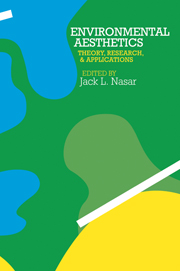Book contents
- Frontmatter
- Contents
- List of figures
- List of tables
- List of contributors and participants
- Acknowledgments
- Preface
- Section I Theory
- Editor's introduction
- 1 Behavioral and perceptual aspects of the aesthetics of urban environments
- 2 Symbolic aesthetics in architecture: toward a research agenda
- 3 Prospects and refuges revisited
- 4 Perception and landscape: conceptions and misconceptions
- 5 Where cognition and affect meet: a theoretical analysis of preference
- 6 The landscape of social symbols
- 7 Open space in cities: in search of a new aesthetic
- 8 Aesthetic perception in environmental design
- Section II Empirical studies
- Section III Applications
- References
- Index of authors
- Subject index
1 - Behavioral and perceptual aspects of the aesthetics of urban environments
Published online by Cambridge University Press: 05 September 2013
- Frontmatter
- Contents
- List of figures
- List of tables
- List of contributors and participants
- Acknowledgments
- Preface
- Section I Theory
- Editor's introduction
- 1 Behavioral and perceptual aspects of the aesthetics of urban environments
- 2 Symbolic aesthetics in architecture: toward a research agenda
- 3 Prospects and refuges revisited
- 4 Perception and landscape: conceptions and misconceptions
- 5 Where cognition and affect meet: a theoretical analysis of preference
- 6 The landscape of social symbols
- 7 Open space in cities: in search of a new aesthetic
- 8 Aesthetic perception in environmental design
- Section II Empirical studies
- Section III Applications
- References
- Index of authors
- Subject index
Summary
This paper offers a theoretical framework that relates the physical and the psychological factors operating in the aesthetic experience of urban environments, and from which hypotheses about preferences can be derived. The environmental features considered are order and complexity. It is argued that the experience of these features is mediated by behavioral and cognitive aspects of the situation. From the behavioral point of view, the significant distinction is between instrumental and diversive behavior. Cognitive aspects are environmental comprehension, or cognitive mapping; the reinforcement or inhibition of formal or informal styles of behavior; and the support or contradiction of beliefs and values.
The need for such a theoretical framework in environmental psychology in general and in the environmental psychology of the city in particular has been well brought out by Proshansky (1978) in his paper “The City and Self–Identity.” The aesthetic psychology of the urban environment is a narrower field, and it is therefore possible to propose a scheme rather simpler than Proshansky's concept of “place identity, ” although certain parallels will appear.
It is not necessary here to discuss in any detail the aesthetic features or qualities of urban settings or to review the contributions of Berlyne (1971), Arnheim (1977), Frances (1977), and others to our understanding of aesthetic psychology in general and of environmental aesthetics in particular. Wohlwill's (1976) pioneering review is still generally relevant, and we can summarize the current state of the art by saying that the importance traditionally assigned to order and complexity as the essential aesthetic features of the environment has been repeatedly confirmed, while very much greater precision has been given to these concepts.
- Type
- Chapter
- Information
- Environmental AestheticsTheory, Research, and Application, pp. 6 - 10Publisher: Cambridge University PressPrint publication year: 1988
- 5
- Cited by



